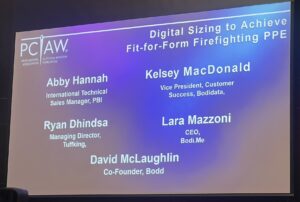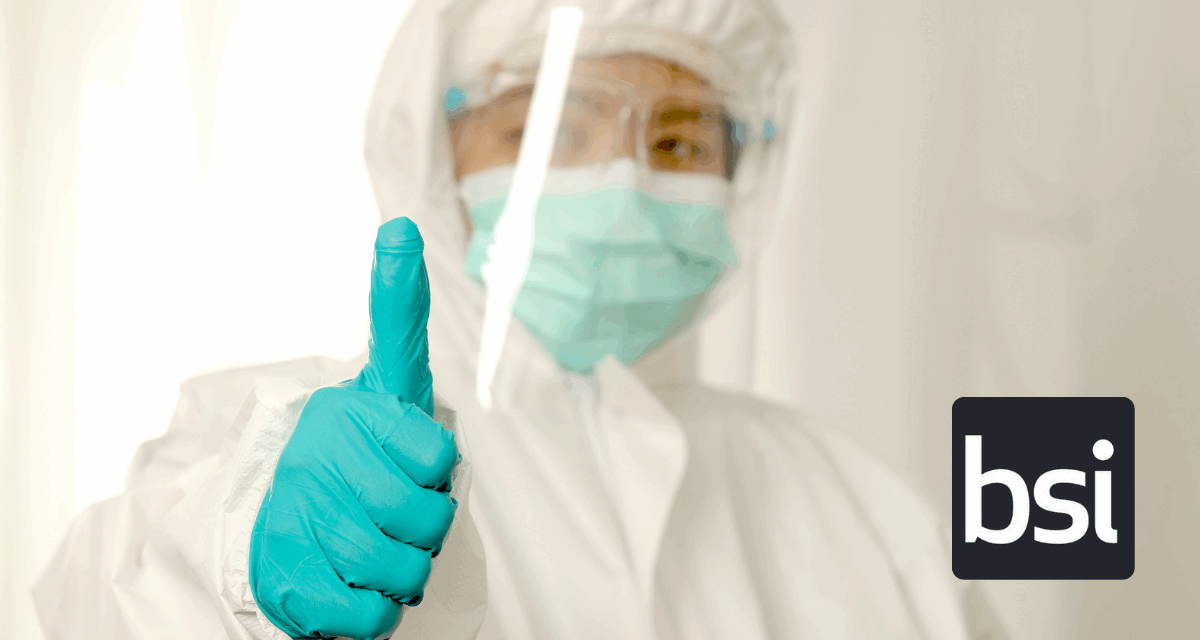Earlier this year, Bodi.Me had the privilege of participating in a digital sizing event organised by PCIAW at a Women in the Fire Service UK training and development event. The exercise revealed alarming mismatches between the standard male-based Personal Protective Equipment (PPE), sizing used in fire departments and the actual body measurements of female firefighters. We had the pleasure of presenting our findings at the PCIAW Summit in London on 30 October during the Digital Sizing to Achieve Fit-for-Form PPE panel discussion.

The research found that almost 20% of the women participating in the activity were smaller than the smallest size available. 75% had hips wider than their chest, a measurement not accounted for in most male-based sizing, and 55% required different size categories for chest and waist, making off-the-shelf gear a poor fit. Poorly fitted PPE can reduce thermal protection by up to 40%, increasing the risk of severe burns and ill-fitting coats create gaps, allowing hazardous chemicals and particulates to enter, raising long-term health risks.
But this is one example of how ill-fitting PPE may compromise safety, efficiency and comfort. Our findings are consistent with other research, including the Global Report on Women’s Access to Proper PPE (view the report at thesafetyrack.org), which found that 94.1% of respondents said they struggled with ill-fitting PPE and 83.5% stated that they have had to modify PPE to fit. The report also states that 65% found that ill-fitting hindered them from performing their duties properly.
PPE is a cornerstone of workplace safety across many industries, including first responders, construction and healthcare. In a world first move, the British Standards Institution (BSI) has now introduced a new standard for inclusive PPE, marking a significant shift towards safer and more equitable workplaces.
What Is the New BSI Standard for Inclusive PPE?
The new BSI standard (BSI BSIF 2025) sets out requirements and guidelines to ensure that PPE is designed, manufactured and supplied to meet the needs of all users, regardless of gender, body shape, ethnicity, or disability. This includes:
- Fit for All: The standard requires that PPE be available in a broad range of sizes, styles, and fits, catering to a diverse workforce.
- Gender Inclusivity: Recognising that protective clothing and equipment must accommodate different body types, the standard calls for options specifically designed for both men and women, as well as non-binary individuals.
- Accessibility: Consideration must be given to those with disabilities or specific health needs.
- Cultural Sensitivity: The standard encourages suppliers to provide PPE that respects cultural and religious practices—such as head coverings or modesty requirements—without compromising safety.
- User Involvement: Employers should consult with employees on PPE selection and involve them in fit testing and trials.
What does this mean for employers and suppliers?
The introduction of these standards places a greater responsibility on employers and suppliers to evaluate the PPE they provide. This may involve updating risk assessments and providing employees with guidance on finding the right fit for both safety and comfort. This is where a cost-effective system like Bodi.Me’s Size-Me platform can make a big difference, saving time and money. Not only do we work closely with brands and manufacturers as part of the consultation period with employees (contact us for NHS case study), but our system offers highly accurate, easy-to-use and non-intrusive size and fit recommendations for each employee.
Getting the fit right first time not only ensures better comfort and safety but also helps manufacturers and employers to reduce returns and waste, saving time and money. Furthermore, the data gathered by the system can also help manufacturers in the production process, supporting the development of new patterns and designs, production planning and inventory management.
Focussing on the Solution:
At the PCIAW Summit on 30 October 2025, Bodi.Me’s presentation looked at how digital sizing can help to achieve fit-for-form PPE. Bodi.Me’s unique sizing intelligence platform is grounded in hounded of thousands of body measurements, thousands of real-world 3D body scans across critical sectors like fire, rail, logistics, and healthcare, and hundreds of thousands of high-quality synthetic datapoints to extend insight across underrepresented groups.
During the presentation, Bodi.Me co-founder, Lara Massoni, explored how this rich data foundation, delivered through the Size-Me platform, is transforming how the professional clothing and PPE industry defines ‘fit’.
“By using validated anthropometric data at scale, we enable brands and manufacturers to move beyond generic size ranges toward intelligent, optimised design decisions—aligning patterns with real body diversity, optimising stock mixes, and improving resource efficiency.” stated Lara. “Our system has been proven to reduce returns by more than 90% in some cases, which in turn also helps to save costs and improve sustainability.”
Challenges and Opportunities:
The new standard may require some initial adjustment, but overall, it is a positive move for everyone. Better-fitted PPE reduces the risk of injury, minimises absenteeism and strengthens an employer’s commitment to diversity and inclusion, making them an attractive prospective employer. Many industry representatives believe that the standard will help struggling sectors attract a wider base of applicants and retain skilled workers.
The new BSI standard is a landmark development in workplace safety, leading the way for other countries to follow suit. By setting out clear expectations for fit, accessibility and user involvement, it aims to ensure that everyone can work safely, comfortably and with confidence.
Find our more about how Bodi.Me can help your business or get in touch for a demonstration: HERE

